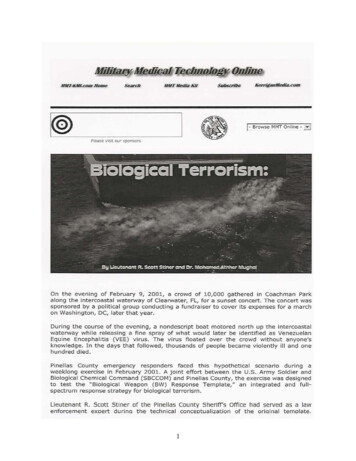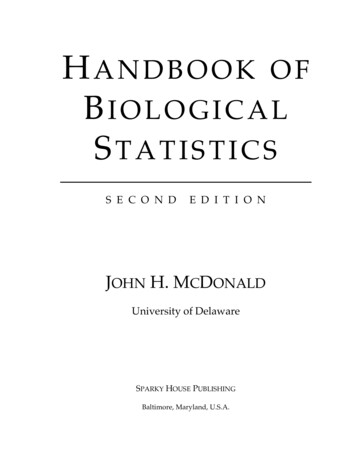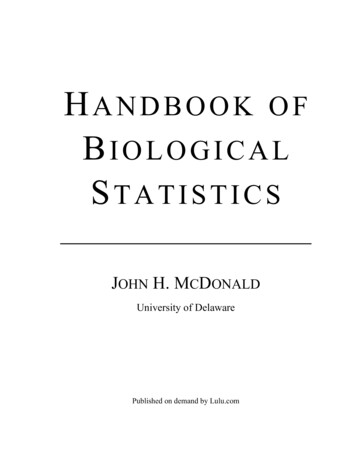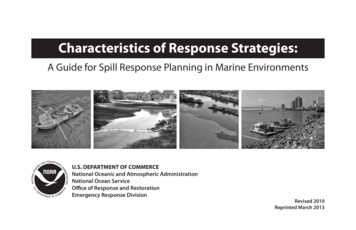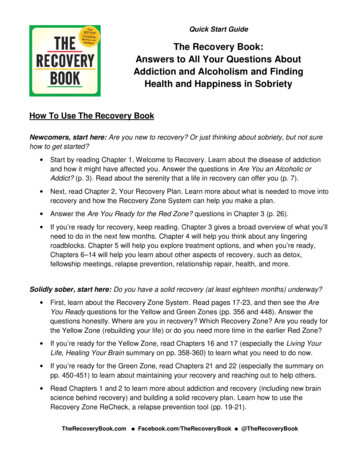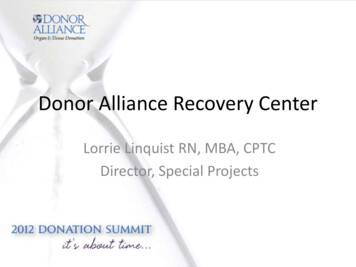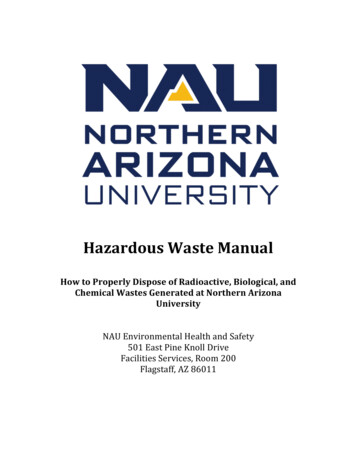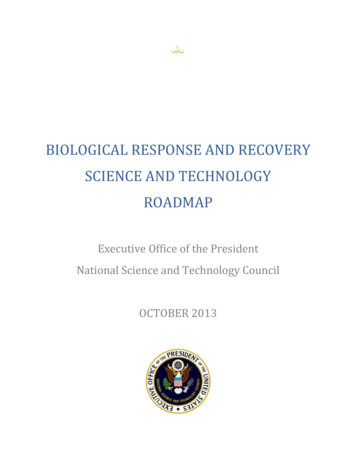
Transcription
BIOLOGICAL RESPONSE AND RECOVERYSCIENCE AND TECHNOLOGYROADMAPExecutive Office of the PresidentNational Science and Technology CouncilOCTOBER 2013
BIOLOGICAL RESPONSE AND RECOVERYSCIENCE AND TECHNOLOGYROADMAP
EXECUTIVE OFFICE OF THE PRESIDENTOFFICE OF SCIENCE AND TECHNOLOGY POLICYWASHINGTON, D.C. 20502October 25, 2013Dear Colleague:I am pleased to transmit the enclosed Biological Response and Recovery Science and TechnologyRoadmap, produced under the auspices of the Committee on Homeland and National Security ofthe National Science and Technology Council (NSTC).The report categorizes key scientific knowledge gaps, identifies technology solutions, andprioritizes research areas to enable government, at all levels, to make decisions more effectivelyduring the response to and recovery from a biological incident—whether naturally occurring orintentional.A catastrophic biological incident could threaten the Nation’s human, animal, plant,environmental, and economic health, as well as America’s national security. Such an eventwould demand a rapid and effective response in order to: (1) minimize loss of life and otheradverse consequences associated with the incident and (2) thwart ongoing threats and follow-onattacks in the case of suspected criminal activity or terrorism.This report builds on the National Biosurveillance Science and Technology Roadmap, which wasreleased by the NSTC in June 2013, and focused on how to better monitor and track events thatcould lead to a biological incident.The new roadmap sets near-term objectives and long-term goals for coordinated research anddevelopment (R&D) activities among Federal agencies to strengthen evidence-based decisionmaking and response and recovery efforts during a biological incident or after one occurs.Thank you for your interest in Federal R&D efforts to ensure the United States is fully able tomount an effective response to and recovery from a catastrophic biological incident. This work iscritically important to the health, safety, and security of our Nation.Sincerely,John P. HoldrenAssistant to the President for Science and TechnologyDirector, Office of Science & Technology Policy
About the National Science and Technology CouncilThe National Science and Technology Council (NSTC) is the principal means by which theExecutive Branch coordinates science and technology policy across the diverse entities that makeup the Federal research and development enterprise. A primary objective of the NSTC isestablishing clear national goals for Federal science and technology investments. The NSTCprepares research and development strategies that are coordinated across Federal departmentsand agencies to form investment packages aimed at accomplishing multiple national goals. Thework of the NSTC is organized under five committees: Environment, Natural Resources andSustainability; Homeland and National Security; Science, Technology, Engineering, and Math(STEM) Education; Science; and Technology. Each of these committees oversees subcommitteesand working groups focused on different aspects of science and technology. More information isavailable at http://www.whitehouse.gov/ostp/nstc.About the Office of Science and Technology PolicyThe Office of Science and Technology Policy (OSTP) was established by the National Scienceand Technology Policy, Organization, and Priorities Act of 1976. OSTP’s responsibilitiesinclude advising the President in policy formulation and budget development on questions inwhich science and technology are important elements; articulating the President’s science andtechnology policy and programs; and fostering strong partnerships among Federal, state, andlocal governments, and the scientific communities in industry and academia. The Director ofOSTP also serves as Assistant to the President for Science and Technology and manages theNSTC. More information is available at http://www.whitehouse.gov/ostp.About the Subcommittee on Biological Defense Research and Development (BDRD)The purpose of the BDRD is to provide all relevant Federal agencies a focused forum forcoordinating and collaborating on defensive research, development, testing, and evaluationaddressing biological threats to national security, including known biological threats(bacteria/viruses/fungi/toxins) and emerging infectious disease agents that have the potential tosignificantly affect the environment, plants, animals, and humans both within the United Statesand throughout the globe. The BDRD has five working groups, including biosurveillance,biological response and recovery, foreign animal diseases, microbial forensics, and bioriskmanagement. This document was developed by the Biological Response and Recovery Scienceand Technology Working Group (BRRST WG).Federal Copyright InformationThis document is a work of the United States Government and is in the public domain (see 17U.S.C. §105). Subject to the stipulations below, it may be distributed and copied withacknowledgment to OSTP. Copyrights to graphics included in this document are reserved by theoriginal copyright holders or their assignees and are used here under the government’s licenseand by permission. Requests to use any images must be made to the provider identified in theimage credits or to OSTP if no provider is identified.
Report prepared byNATIONAL SCIENCE AND TECHNOLOGY COUNCILCOMMITTEE ON HOMELAND AND NATIONAL SECURITY (CHNS)SUBCOMMITTEE ON BIOLOGICAL DEFENSE RESEARCH AND DEVELOPMENT(BDRD)BIOLOGICAL RESPONSE AND RECOVERY SCIENCE AND TECHNOLOGYWORKING GROUP (BRRST WG)National Science and Technology CouncilChairJohn P. HoldrenAssistant to the President for Science andTechnology and Director,Office of Science and Technology PolicyStaffPedro I. Espina (through May 31, 2013)Executive DirectorJayne B. Morrow (beginning June 1, 2013)Executive DirectorCommittee on Homeland and National SecurityChairsPatricia FalconeAssociate Director for National Securityand International AffairsOffice of Science and Technology PolicyTara O’TooleUndersecretary of Homeland Security forScience and TechnologyDepartment of Homeland SecurityAlan R. ShafferActing Assistant Secretary of Defensefor Research and EngineeringDepartment of DefenseStaffSusan LawExecutive SecretaryDepartment of Homeland SecuritySubcommittee on Biological Defense Research and DevelopmentChairFranca JonesOffice of Science and Technology PolicyStaffJayne B. Morrow (through May 31, 2013)Executive SecretaryNational Institute of Standards and TechnologyDepartment of Commerce
Biological Response and Recovery Science and Technology Working GroupCo-ChairJayne B. MorrowNational Institute of Standards and Technology(through May 31, 2013)Department of CommerceCo-ChairJohn F. KoernerAssistant Secretary of Preparedness andResponseDepartment of Health and Human ServicesStaffBrooke PearsonExecutive SecretaryMembersDave AdamsMatthew ArduinoMark BeallErica CanzlerLisa DelaneyAaron FirovedSonia HuntGeorge KorchJames LawlerHelen LawrenceRyan MaddenTyler McAlpinServiceLori MillerStephen MorseShawn RyanJill SheetsLynn SlepskiTheresa SmithMargaret SobeyAngela WeberDepartment of Homeland Security–Office of Health AffairsDepartment of Health and Human Services–Centers for Disease Controland PreventionDepartment of Defense–Office of the Assistant Secretary of Defense forHomeland DefenseEnvironmental Protection Agency–Office of Emergency ManagementDepartment of Health and Human Services–Centers for Disease Controland PreventionDepartment of Homeland Security–Office of Health AffairsDepartment of Justice–Federal Bureau of InvestigationDepartment of Health and Human Services–Office of the AssistantSecretary for Preparedness and ResponseDepartment of Health and Human Services–National Institutes of HealthDepartment of Justice–Federal Bureau of InvestigationDepartment of Defense–Defense Threat Reduction AgencyU.S. Department of Agriculture–Animal and Plant Health InspectionDepartment of Homeland Security–Science and TechnologyDepartment of Health and Human Services–Centers for Disease Controland PreventionEnvironmental Protection Agency–National Homeland SecurityResearch CenterDepartment of Justice–Federal Bureau of InvestigationDepartment of TransportationExecutive Office of the President–National Security StaffDepartment of Defense–Joint Program Executive Office for Chemicaland Biological DefenseDepartment of Health and Human Services–Centers for Disease Controland Prevention
Abbreviations and Acronyms ListAAPASDWAASPRASTHOBDRDBOTEBRRST et-LIRNWARRPWGAmerican Academy of PediatricsAssociation of State Drinking Water AdministratorsAssistant Secretary for Preparedness and ResponseAssociation of State and Territorial Health OfficialsBiological Defense Research and DevelopmentBio-response Operational Testing and EvaluationBiological Response and Recovery Science and Technology Working GroupChemical, Biological, Radiological, and NuclearCenters for Disease Control and PreventionCommittee on Homeland and National SecurityDecontamination Decision Support ToolDecontamination Family of SystemsDepartment of Homeland SecurityDepartment of DefenseDefense Threat Reduction AgencyEmergency Management Modernization ProgramEnvironmental Protection AgencyFederal Bureau of InvestigationFood and Drug AdministrationFood Emergency Response NetworkGeographic Information SystemsHealth and Human ServicesHuman Remains Decontamination SystemIntegrated Consortium of Laboratory NetworksJoint Program Executive Office for Chemical and Biological DefenseLaboratory Response NetworkMedical CountermeasuresNational Association of County and City Health OfficialsNorth American Soil Geochemical Landscapes ProjectNational Environmental Health AssociationNational Homeland Security Research CenterNational Science and Technology CouncilOffice of Science and Technology PolicyPublic Health Emergency Medical Countermeasures EnterpriseRapid Viability Polymerase Chain ReactionStandard Operating ProcedureScientific Program on Reaerosolization and ExposureScience and technologyScience, Technology, Engineering, and MathTransatlantic Collaborative Biological Resiliency DemonstrationUnited States Department of AgricultureU.S. Geological SurveyVeterinary Laboratory Investigation and Response NetworkWide Area Recovery and Resiliency ProgramWorking Group
Table of ContentsExecutive Summary . 1Chapter 1 . 2Introduction. 2Background . 2Overview of the Response and Recovery Process . 3Capability Gaps . 4Roadmap Development Process. 4Purpose and Scope . 5Chapter 2 . 7Capability Goals to Support Critical Response and Recovery Decisions . 7Goal 1: Characterize the extent of the incident to reduce exposure and save lives. . 7Goal 2: Effectively communicate to reduce the impacts of a biological incident. . 9Goal 3: Accurately assess risk of exposure and risk of infection. 12Goal 4: Reduce the risk of exposure and/or infection. . 13Goal 5: Manage biological waste following a catastrophic incident. . 15Conclusions . 18Appendix I: Definitions . 19
Executive SummaryA catastrophic biological incident could threaten the Nation’s human, animal, plant,environmental, and economic health, as well as America’s national security. Such an eventwould demand a quick and effective response in order to minimize loss of life and other adverseconsequences and, in the case of suspected criminal activity or terrorism, to thwart ongoingactivity and prevent follow-on attacks. But response and recovery from a catastrophic biologicalincident is not a simple, formulaic process. Rather, it is a continuous process of data andinformation collection, evidence-based review, and decision making, all leading to an informedand constantly evolving series of critical and coordinated actions. Moreover, the response andrecovery process involves the integration and coordination of data and capabilities from manydifferent sectors, including public health, law enforcement, waste management, infrastructuremanagement, and transportation. Strategic science and technology (S&T) investments areessential to provide the information that can support evidence-based operational decisions andstrengthen response-and-recovery efforts. This report categorizes key scientific knowledge gaps,identifies technology solutions to these gaps, and prioritizes research areas that will enablegovernment at all levels to make decisions more effectively during the response to, andrecovery from, biological incidents.The prioritized, near-term objectives and broader, long-term goals presented in this reportconstitute a roadmap for use by Federal departments and agencies to coordinate their researchand development (R&D) activities. The primary near-term objectives whose timely achievementthis roadmap aims to facilitate are: Establish the location(s) of the confirmed biological agent in the environment;Develop reliable estimates of risk of exposure for a multitude of environments, matrices,and conditions associated with wide-area release scenarios;Develop reliable estimates of risk to humans, animals, and plants through various exposureand transmission routes;Develop risk reduction strategies, including decontamination, waste management,contaminant control, and reaerosolization control, for a variety of biological threats andscenarios;Evaluate population infection prevention measures (e.g., quarantine, isolation, and socialdistancing) used to reduce incident impact and develop a strong scientific basis forrecommending these measures; andUse risk communication research to guide development of appropriate messages anddissemination means to stakeholders, including decision makers, first responders, thepublic, and the media.Coordination of R&D agendas among Federal departments and agencies will reduce duplicationof effort and enhance efficiencies as the Nation enhances its capacity to prevent, protect against,mitigate, respond to, and recover from catastrophic biological incidents.1
Chapter 1Introduction“Just as we step up our ability to prevent an attack, we must also bolster our capacity to protect against— and respond to — the threats that may come. When it comes to bioterror, this can mean thedifference between a contained incident and a catastrophe. That's why we need to invest in newvaccines, to reduce the risk posed by those who would use disease as a weapon. That's why we mustdevelop the technology to detect attacks and to trace them to their origin, so that we can react in atimely fashion. And to care for our citizens who are infected, we must provide our public health systemacross the country with the surge capacity to confront a crisis. Making these changes will do more thanhelp us tackle bioterror — it will create new jobs, support a healthier population, and improve America'scapability to respond to any major disaster.”—President Barack Obama (July 16, 2008)BackgroundA biological incident may be caused by a naturally-occurring outbreak with a human, plant, oranimal pathogen, such as the 2009 H1N1 pandemic; the deliberate dissemination of pathogens,such as the 2001 U.S. anthrax attacks; or the accidental release of biological agents, such as the2007 release of foot-and-mouth disease virus from a laboratory in the United Kingdom. Suchevents can have devastating impacts on public, animal, or plant health, the economy, criticalinfrastructure, military readiness, and public confidence. Effective response to and recovery froma catastrophic biological incident can mitigate all those risks, but will depend upon rapid, sounddecisions being made by response personnel and government officials.In working toward that goal, the Secretaries of the U.S. Departments of Health and HumanServices, Agriculture, Interior, Defense, Commerce, and Homeland Security, as well as theAdministrator of the Environmental Protection Agency and the U.S. Attorney General, with thesupport of other Federal partners, are guided by the National Response Framework1 and specificPresidential Policy Directive-82 frameworks to support local authorities in making criticaldecisions to enable effective response and recovery from a biological incident.To ensure the United States is fully able to mount an effective response to and recovery from acatastrophic biological incident, the Subcommittee on Biological Defense Research andDevelopment (BDRD), under the Committee on Homeland and National Security of the NationalScience and Technology Council, chartered the Biological Response and Recovery Science andTechnology (BRRST) Working Group (WG) to assess biological incident response and recoverycapabilities and recommend a way forward towards addressing scientific knowledge ortechnological gaps to improve decision making.1Federal Emergency Management Agency, National Response Framework, Second Edition, Department ofHomeland Security, May, 2013.2Presidential Policy Directive / PPD-8: National Preparedness March 30, 2011.2
Overview of the Response and Recovery ProcessResponse to and recovery from a catastrophic biological incident requires a continuous andcoordinated process of data and information collection, review, and decision making that resultsin a series of critical and coordinated actions (Figure 1). Science and technology (S&T) providethe knowledge and tools for effective response and recovery operations. Throughout the responseand recovery process, decisions depend on what is known about the agent’s transmissiondynamics, chain of infection, and other data that may change or evolve as the incident maturesand the response unfolds. Response includes those capabilities necessary to save and sustainlives; mitigate human, environmental, plant, and animal health impacts; stabilize the incident;protect property and the environment; meet basic human needs after an incident has occurred;and, in the case of suspected Federal crimes or terrorism, thwart continued activity and preventfollow-on attacks. The ability to make sound decisions in the first minutes, hours, and daysfollowing an incident can make a significant difference in lives saved, extent of the spread ofdisease, and duration of the overall recovery.Key elements of an effective biological response and recovery are described in the 2009 Draftdocument, “Planning Guidance for Recovery Following Biological Incidents”3. Briefly, the firstphase of activities includes detection and confirmation of a biological incident, followed bynotification/early warning and first response. Decisions to begin notification procedures andinitiate communications regarding an incident require confidence in the identification andconfirmation process, as well as guidance on operational coordination and communicationsstrategies for disseminating information about the incident to appropriate authorities and thepublic.Notification/early warning procedures provide situational awareness by confirming for properauthorities and the public that a biological incident has occurred. First response is a series ofdecisions and actions immediately following notification that aim to effectively control, contain,investigate, and mitigate the effects of a biological incident. First response may include initialsite containment, environmental sampling and analysis, and public health activities such astreatment of potentially exposed persons and industry engagement. It may also include a lawenforcement response, tactical and technical operations, designation of crime scenes, and relatedactivities.Restoring basic services and supporting the transition to recovery are also critical elements of atimely response to a biological incident. Restoration and recovery encompass the process ofreturning a community to a state of normality after a disastrous biological incident and requires,among other elements, ongoing characterization of the environment to determine health risks.Efforts to support restoration and, as appropriate, re-occupancy following a biological incidentinclude elements of communicating the risk associated with returning an area to normal use andhow best to reduce risk of infection or exposure through remediation processes. Federal, state, orlocal public health officials, government departments and agencies, and/or property owners(depending on site-specific jurisdictional authorities) make final decisions on clearance.3Subcommittee on Decontamination Standards and Technology Committee on Homeland and National Security,Draft Planning Guidance for Recovery Following Biological Incidents, National Science and Technology Council, May2009.3
Environmental stability of biological pathogens varies greatly among various organisms, andrestoration, clearance, and re-occupancy can range from relatively uncomplicated processes tolarge-scale decontamination processes.Capability GapsWhile substantial progress has been made to prevent, detect, respond to, and recover fromnatural, accidental, and intentional outbreaks, additional focused S&T efforts that leverageinvestments by Federal departments and agencies and integrate knowledge from advancementsin the biological sciences are required to fill critical capability gaps that currently hamperdecision makers. Among the numerous factors that can undermine an effective response to anincident are the lag between the incident occurrence and its detection and/or confirmation; lackof understanding of agent spread, transport, and persistence in the environment; lack of clarityabout the actual impacted or contaminated area; and uncertainty due to technical limitations andgaps in knowledge and information to drive decision making. Additionally, biologicalcontamination with certain agents presents unique remediation challenges because of the abilityof the agent to infect and replicate in a host and/or persist or propagate and thrive in theenvironment. For example, periodic natural outbreaks of anthrax in animals throughout the worlddemonstrate the persistence and transport of the organism in the environment. Likewise, seasonaloutbreaks of influenza show a persistence of the causative virus in human and animal reservoirs.Biological structure, metabolic characteristics, and natural history of biological agents inconjunction with the physical and climatic conditions in the surrounding environment define thesurvival rate and hence the fate of the agent outside of its host or hosts. Changing conditionsaffect the presence and persistence of an agent in the environment, which influences the riskposed and drives the choice of risk-reduction strategies. Therefore, response and recoveryprocesses, including a variety of risk-reduction strategies, are dependent upon a comprehensiveunderstanding of the agent and the human and environmental contexts in which it exists.Roadmap Development ProcessTo define the path forward outlined in this Roadmap, the BRRST WG developed a workingdocument that described the decisions that first responders or government officials would need tomake following a biological incident, what questions the decision maker might ask, and, of thosequestions, which could be addressed with scientific information or technological capabilities.While the framework established in the draft “Planning Guidance for Recovery FollowingBiological Incidents” focuses only on remediation/cleanup recovery operations aftercontamination with Bacillus anthracis, the causative agent of anthrax, that framework serves as astarting point for describing the decisions that need to be made in response to biologicalincidents in general. Based on the phases and activities outlined in that framework, the BRRSTWG developed a list of major (high-impact) decisions that would need to be made during eachphase of response and recovery (Figure 1). (The decisions and activities presented in Figure 1 arenominally categorized according to their relative timing within the response and recoverytimeline but the timing of their implementation can vary—e.g., some limited decontaminationoperations and waste generation may begin with the first response activities and implementingpublic messaging generally occurs throughout the entire process).The resultant working document was used to guide discussions and to collect Federal departmentand agency information on current and planned programmatic activity with the potential to4
address the questions answerable by S&T. Review of submitted information on Federal activitiesdrove the development of S&T capability goals and objectives. Those goals and objectivesconstitute the heart of this Roadmap and comprise a guide for future Federal, academic, andindustrial S&T efforts and for international collaborations. Sidebars highlighting some successfulS&T programs have been included in this report as well, to demonstrate where current programsare working to address some of the gaps identified and where expansion of ongoing activitieswould be beneficial. While the intent was to create a Roadmap that applies to a variety ofbiological agents, it should be noted that many components and highlighted programs in thisRoadmap apply in particular to agents that pose the difficult challenge of persisting in theenvironment (e.g., Bacillus anthracis).Purpose and ScopeThe strategic goals and objectives presented in this Roadmap aim to focus Federal S&T effortswith the goal of enhancing operational decisions at various phases of the response and recoveryprocess. This Roadmap complements, but does not duplicate, ongoing S&T collaboration in thearea of Biosurveillance and Medical Countermeasures (MCM) that address S&T needs forprotection against the occurrence of a biological incident; initial detection, diagnosis, orconfirmation of a biological agent; prediction of the occurrence of or forecasting the impact of abiological incident or the development and use of MCM.5
Response and RecoveryCrisis ManagementNotificationInitiate firstresponseactivities,includingnotificationof properauthoritiesDevelop Consequence ManagementRemediation/CleanupFirst ResponseOperational CoordinationLaw enforcement, intelligence,and investigative responseWhen and how to distributemedical countermeasuresRecommend staying-in-place stancingImplement transportationrestrictionsProvide safety and health guidanceand protections to impacted firstresponders and citizensIssue guidance on personalhygiene or decontaminationProvide support for mass velop/ implementstrategies forcharacterization infacilities and theoutdoorsImplement strategiesand procedures toidentify, stabilize, andmaintain infrastructureand propertyDecontaminateoutdoor areas and/orbuildingsDecontaminatewide areasProvide guidancefor determinationof effectiveness ofdecontaminationDeterminerequirements andmethods to protectnatural and culturalresourcesImplement strategiesand means to containand mitigate the spreadof contamination andeliminate sources offurther distribution(e.g., insecticides forflies)Implement requiredcapabilities Implementdecontaminationwaste ctureRestoration/Re-occupancyProvide guidance forre-occupancy and reusecriteria and goalsProvide guidance forcontrols to implement,reduce, mitigate anypotential exposures orfuture incidents afterre-occupancyImplement publicmessaging to instillconfidence in the publicand workforce that reoccupancy is safeImplement measures toretain, maintain andimprove the economicvitality of a regionImplement long termhealth treatment,intervention andsurveillance strategyEstablish mass medical treatmentfacilitiesImplement modified standards ofcareFigure 1. Key Response and Recovery Decisions6
Chapter 2Capability Goals to Support Critical Response and Recovery DecisionsThis Roadmap presents the S&T needs to support the following critical operational decisions thatmay be required at various phases of response and recovery following confirmation of abiological incident: Develop/implement strategies for characterization both indoors and outdoorsDetermine when and
EXECUTIVE OFFICE OF THE PRESIDENT OFFICE OF SCIENCE AND TECHNOLOGY POLICY WASHINGTON, D.C. 20502 October 25, 2013 Dear Colleague: I am pleased to transmit the enclosed Biological Response and Recovery Science and Technology Roadmap, produced under the auspices of the Committee on Homeland and National Security of the National Science and Technology Council (NSTC).


